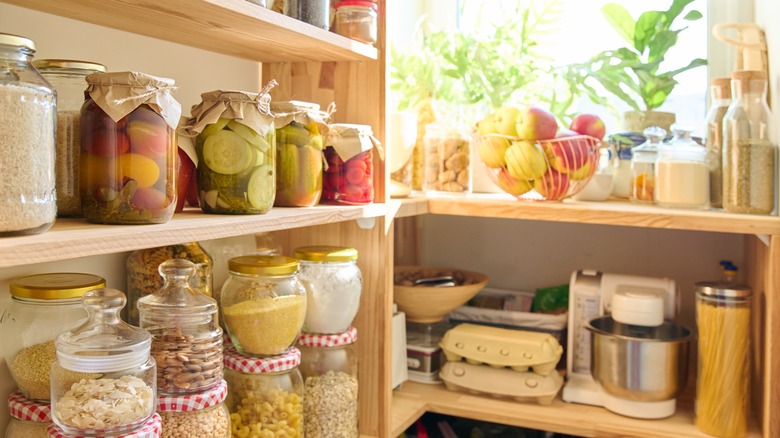The No. 1 Organization Rule For Safer Food Pantry Stocking
Meal prepping saves time and money, and it can help you eat healthier because you won't be tempted to grab fast food or junk food when you are low on time and energy. It also reduces stress, knowing you have healthy, delicious meals ready at home. But it's really hard to properly meal prep if your food pantry is disorganized.
Organizing a pantry, much like meal prepping, can help save time, reduce stress, and save money by making meal planning and grocery shopping easier and faster. There are many ways to organize your pantry, and sites like Instagram and Pinterest are full of tips and hacks, like the best organizers and methods to fully use the space you have. While these hacks help make your pantry look neat and make it easier to find your food items, most don't look at the ways to safely stock a pantry. After all, the number one rule for pantry organization is also necessary for safety.
Keeping heavier things low for safety
To safely stock your pantry, you should always keep heavy items on the bottom. This includes large cans, heavier bags of rice, or jugs of water or juice. Anything that can fall and hurt you should never go over your head. These heavier items could also weigh down your pantry shelves and cause them to bend or break, so keeping them on the bottom of the pantry, which is often reinforced, ensures that your pantry is safe from breaking and safe from accidental injuries.
If you do need to lift these heavier items from lower shelves, be sure that you lift them with your legs. In other words, don't bend over and pick up anything too heavy because that can injure your back. If you are worried about hurting yourself by picking up things off the lower shelves, stock heavier pantry items at waist height, but you should space heavy items out to make sure your shelves don't break.
Other ways to keep your pantry safe and organized
There are some other great rules and hacks to stock your pantry safely. For one, you should remove everything from the pantry and give it a good cleaning. Then, check the expiration dates on your products. If they are expired, get rid of them. If they are near their expiration date, move those products to the front and put newer products in the back. This helps you to know what products are the freshest.
If you intend to put things in airtight storage containers rather than the package they come in, you should always label the container with what the food product is and when it expires. Plus, you should keep frequently used items at eye level to make it easy to grab what you need without having to dig through the pantry and keep like-items grouped together so you can easily see what you have.


